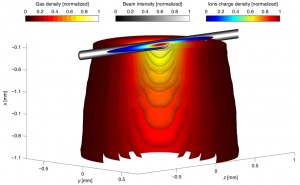Physicists from Ben-Gurion University Achieve Breakthrough in Measuring Ultrafast Laser Pulses
GA, UNITED STATES, April 28, 2025 /EINPresswire.com/ -- Researchers at Ben-Gurion University have achieved a major breakthrough in measuring ultrafast laser pulses, overcoming a long-standing challenge in strong-field physics. Led by Dr. Eugene Frumker, the team developed a precise method to measure laser intensity and duration at the interaction point using ion analysis. This advancement improves accuracy in laser-driven experiments, paving the way for new discoveries in attosecond science and strong field physics.
A research team from Ben-Gurion University of the Negev has successfully measured and characterized extremely powerful laser pulses lasting just a few femtoseconds—an achievement that overcomes a decades-old challenge in strong-field physics and attosecond science.
The research group, led by Dr. Eugene Frumker, has developed a groundbreaking method to accurately determine the intensity and duration of these ultrafast pulses—a crucial advancement for improving precision in laser-driven experiments.
Their findings were just published in one of the top journals in the field, Light: Science & Applications (LSA).
Amplified ultrafast laser pulses are among the most intense bursts of energy ever created—briefly surpassing the combined power output of all the world’s power stations, though only for a few millionths of a billionth of a second. In attosecond science experiments, these pulses are tightly focused to a spot smaller than the width of a human hair, where they interact with matter at extreme intensities.
However, a long-standing challenge has been the difficulty of precisely measuring these laser pulses at the point of interaction. Existing methods can be inaccurate by as much as 50%, leading to uncertainty in experimental results. Without knowing the exact intensity and duration of these pulses, scientists cannot achieve the level of precision required for cutting-edge discoveries.
Dr. Frumker and Noam Shlomo, a Ph.D. student in his research group, have developed a breakthrough method to directly measure the laser's intensity and duration at the point of interaction with atoms, providing significantly greater accuracy than previous techniques.
“At first glance, the problem may seem straightforward: simply measure fundamental laser pulse characteristics such as energy, width, and duration, then calculate the peak intensity. However, it has long been known that this approach often results in unacceptably large errors,” says Dr. Frumker.
“Moreover, high-power ultrafast laser systems often experience fluctuations in pulse intensity and variations in their spatial and temporal profiles. Given the highly nonlinear nature of strong-field interactions, these factors further complicate the problem. That’s why a reliable in situ method to accurately measure and control these parameters in the interaction region is critical for all areas of strong-field laser physics.”
Their method works by analyzing ions—electrically charged atoms—created when the laser interacts with a gas. By carefully measuring these ions, the team can precisely determine the laser’s intensity and duration at the exact point of interaction. They have successfully tested this technique with different gases, such as helium and argon, demonstrating its reliability and consistency. Additionally, their theoretical model closely aligns with their experimental data, further validating their approach.
This breakthrough represents a major step forward for strong field and attosecond science, enabling more precise experiments that could lead to a deeper understanding of atomic and molecular behavior on ultrafast timescales. While the primary impact is on fundamental scientific research, this advancement could also contribute to future technologies in areas such as ultrafast electronics, advanced materials, and even next-generation medical imaging and diagnostics.
References
DOI
10.1038/s41377-025-01808-y
Original Source URL
https://doi.org/10.1038/s41377-025-01808-y
Funding Information
This work was supported by Israel Science Foundation (ISF) grant 2855/21.
Lucy Wang
BioDesign Research
email us here
Legal Disclaimer:
EIN Presswire provides this news content "as is" without warranty of any kind. We do not accept any responsibility or liability for the accuracy, content, images, videos, licenses, completeness, legality, or reliability of the information contained in this article. If you have any complaints or copyright issues related to this article, kindly contact the author above.
S Hotel Montego Bay Named Tripadvisor Travelers’ Choice Awards Best of the Best Winner for 2025
Mega Foods Officially Launches Mega Chili Powder at Besame Mucho Festival in Austin, Texas
Vietnam Equestrian Club Expands Rider Base by Raising Weight Limits This Summer
Kalendarium
Więcej ważnych informacji
 Jedynka Newserii
Jedynka Newserii

 Jedynka Newserii
Jedynka Newserii

Bankowość

Coraz mniej kredytów bankowych płynie do polskiej gospodarki. Przed sektorem duże wyzwania związane z finansowaniem strategicznych projektów
Polskie przedsiębiorstwa w coraz mniejszym stopniu finansują się kredytem bankowym, zwłaszcza w porównaniu z rosnącym PKB. Powoduje to wysoką nadpłynność sektora bankowego. Deregulacja mogłaby pomóc w skróceniu drogi firm do finansowania bankowego, zwłaszcza że Polskę czekają ogromne wydatki na transformację energetyczną i obronność. Sektor ma bardzo dobre wyniki finansowe, co powoduje, że politycy patrzą w stronę jego zysków. Ryzyko prawne, jakim wciąż są kredyty frankowe, pociąga za sobą brak zainteresowania ze strony zagranicznych inwestorów.
Firma
Bezrobocie może zacząć rosnąć. Ochłodzenie odczuwane szczególnie w branży budowlanej i automotive

W Polsce od kilku lat stopa bezrobocia utrzymuje się poniżej 6 proc., a według metodologii unijnej jest o połowę niższa i jedna z najniższych w Unii. Pracownicy przywykli już, że sytuacja na rynku pracy jest dla nich korzystna. Jednak zaczynają się pojawiać pierwsze niepokojące sygnały zwiastujące możliwą zmianę trendu. Część branż ucierpiała np. z powodu spowolnienia w Niemczech, inne rozważają wybór innej niż Polska lokalizacji ze względu na wysokie koszty pracy czy energii. Na razie ogromnym wyzwaniem pozostaje aktywizacja osób biernych zawodowo.
Ochrona środowiska
Rozwój sztucznej inteligencji drastycznie zwiększa zapotrzebowanie na energię. Rozwiązaniem są zrównoważone centra danych

Centra danych to jeden z dynamicznie rozwijających się, ale przy tym energochłonnych sektorów gospodarki. Prognozy PMR wskazują, że do 2030 roku operatorzy w Polsce będą dysponować centrami danych o mocy przekraczającej 500 MW, co oznacza, że wzrośnie ona ponad trzykrotnie względem 2024 roku. Przyspieszona cyfryzacja i dynamiczny rozwój sztucznej inteligencji sprawiają, że w ciągu kilku następnych lat zużycie energii elektrycznej w centrach danych tylko w Europie wzrośnie o 66 proc. Dlatego coraz więcej firm sięga po zrównoważone rozwiązania i energię pochodzącą ze źródeł odnawialnych.
Partner serwisu
Szkolenia

Akademia Newserii
Akademia Newserii to projekt, w ramach którego najlepsi polscy dziennikarze biznesowi, giełdowi oraz lifestylowi, a także szkoleniowcy z wieloletnim doświadczeniem dzielą się swoją wiedzą nt. pracy z mediami.



![Europejskie miasta planują wzrost inwestycji w infrastrukturę społeczną. Wydatki na niskoemisyjny transport wciąż są niewystarczające [DEPESZA]](https://www.newseria.pl/files/1097841585/panel-dotacje-foto,w_85,_small.jpg)





.gif)

 |
| |
| |
|